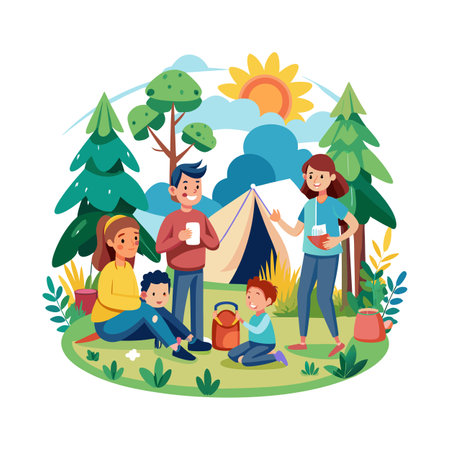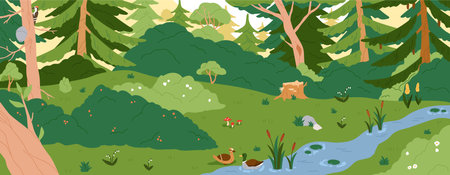1. Planning Your Backpacking Adventure
Backpacking in the American wilderness is an unforgettable experience, but it all starts with good planning. Whether youre heading to the Rocky Mountains, the Appalachian Trail, or deep into a remote national park, being prepared can make your trip safer and more enjoyable.
Choosing the Right Trail
The U.S. offers thousands of miles of trails across various terrains—from desert landscapes to alpine forests. Picking the right trail depends on your fitness level, experience, and the kind of scenery you want to explore.
Consider These Factors When Choosing a Trail:
| Factor | Description |
|---|---|
| Difficulty Level | Beginners should start with well-marked and shorter trails, while experienced hikers can tackle challenging routes with steep climbs or rough terrain. |
| Trail Length | Choose a trail length that matches your available time and physical ability. Multi-day treks require careful planning for food and rest stops. |
| Location | Decide if you want a remote backcountry experience or something closer to civilization. National parks often offer both options. |
| Highlights | Research if the trail includes scenic overlooks, lakes, waterfalls, or wildlife viewing opportunities. |
Setting Realistic Goals
Its easy to get ambitious when planning a trip, but it’s important to be honest about your limits. Overestimating how far you can hike each day can lead to exhaustion or even injury.
Tips for Setting Achievable Daily Mileage:
- If youre new to backpacking: aim for 5–8 miles per day.
- If youre moderately experienced: 8–12 miles per day is reasonable.
- If youre seasoned and fit: 12–20+ miles may be manageable depending on elevation and pack weight.
Planning Logistics
Permits and Regulations
Many popular wilderness areas—like Yosemite or Glacier National Park—require permits for overnight trips. Always check with the parks website or ranger station before heading out. Some permits are limited and must be reserved months in advance.
Weather Considerations
The weather in American wilderness areas can change quickly. Summer thunderstorms in the Rockies or early snow in the Sierra Nevada are not uncommon. Always check forecasts before your trip and prepare for temperature swings by layering your clothing.
Seasonal Conditions
| Season | Conditions & Tips |
|---|---|
| Spring (Mar–May) | Snow may still cover high elevations; trails could be muddy. Great time for lower elevation hikes. |
| Summer (Jun–Aug) | The most popular season; expect crowds in national parks. Watch out for heat, bugs, and afternoon storms. |
| Fall (Sep–Nov) | Milder weather and fewer bugs. Be cautious of early snow at higher altitudes. |
| Winter (Dec–Feb) | Difficult conditions with snow and ice; only attempt if you have winter hiking experience and gear. |
Quick Checklist Before You Go:
- Select a trail that matches your skill level and interest.
- Create a realistic itinerary based on daily mileage goals.
- Secure necessary permits ahead of time.
- Check the weather forecast regularly leading up to your trip.
- Understand seasonal conditions for your destination area.
- Tell someone where youre going and when you plan to return.
A little preparation goes a long way when it comes to exploring America’s vast backcountry. The right planning sets the stage for an incredible journey into nature’s wildest places.
2. Essential Gear and Packing Tips
Before heading out into the American wilderness, having the right gear and knowing how to pack it can make or break your backpacking trip. From ultralight essentials to safety must-haves, every item in your pack should serve a purpose. Heres how to gear up smartly for your adventure.
Must-Have Backpacking Gear
Choosing the right gear is all about balancing weight, function, and durability. Here’s a list of essentials you’ll need for most backpacking trips in the U.S.
| Item | Description | Why It Matters |
|---|---|---|
| Ultralight Tent or Shelter | A lightweight, weather-resistant tent or tarp system | Reduces pack weight while providing necessary protection |
| Sleeping Bag & Pad | Appropriate temperature rating and insulation with a compact pad | Keeps you warm and comfortable through the night |
| Backpack (45–65L) | Well-fitted pack with good support and compartments | Carries all your gear efficiently without straining your back |
| Bear-Proof Food Container | Bear canister or Ursack depending on regulations | Keeps wildlife safe and your food secure—required in many areas |
| Water Filtration System | Squeeze filter, pump, or UV purifier | Makes natural water sources safe to drink |
| Navigation Tools | Map, compass, GPS device or smartphone app (with offline maps) | Helps you stay on track and avoid getting lost in remote areas |
| First Aid Kit | Basic supplies plus any personal medications | Treats minor injuries and handles emergencies until help arrives |
| Headlamp with Extra Batteries | Hands-free lighting solution for nighttime use | A must for setting up camp or navigating after dark |
Packing Smart: Tips for Efficiency, Safety, and Comfort
Create a Packing System
Divide your gear into categories such as shelter, sleep system, cooking, clothing, and emergency items. Use stuff sacks or packing cubes to organize them by function so youre not digging through your whole bag each time you need something.
Pack by Weight Distribution
Heavier items like food and water should be packed close to your back and centered between your shoulder blades. Lighter items can go at the top or bottom of your pack. This helps balance the load and reduces strain during long hikes.
Clothing Tips for Wilderness Travel
| Layer Type | Example Items | Packing Tip |
|---|---|---|
| Base Layer (Moisture-Wicking) | Synthetic or merino wool shirts/leggings | Avoid cotton; bring extras for sleeping/dry wear |
| Insulating Layer (Warmth) | Puffy jacket or fleece pullover | Packs small but keeps body heat in cold temps |
| Shell Layer (Protection) | Rain jacket/pants, windbreaker | Carries easily and shields against wind/rain/snow |
Food Planning & Storage Tips
- Plan meals that are lightweight but high in calories—think dehydrated meals, nuts, jerky, oatmeal.
- Use resealable bags to portion meals and reduce packaging waste.
- If in bear country, always store food away from camp—at least 100 feet—and use a bear-proof container as required by local regulations.
Pro Tip:
If youre new to backpacking, do a “shakedown hike” before your big trip. Load up your pack with all your gear and do an overnight nearby. It’s a great way to test what works—and what doesn’t—before heading deep into the wild.
The right gear setup doesnt have to be expensive or complicated. With careful planning and mindful packing, youll feel more prepared and confident exploring Americas vast wilderness landscapes.

3. Navigating the Wild Safely
When youre deep in the American wilderness, knowing how to navigate can be the difference between a great adventure and a dangerous situation. Even if you’ve got a smartphone with GPS, you can’t always rely on signal or battery life out in remote areas. That’s why it’s essential to understand old-school tools like maps and compasses, along with modern GPS devices.
Map and Compass Basics
A topographic map shows you more than just roads—it includes elevation, trails, rivers, and landmarks. Pair it with a compass, and you have a powerful way to stay on track even when theres no cell service.
How to Use Them Together:
| Step | Description |
|---|---|
| 1. Orient Your Map | Use your compass to align the map with true north so features match what you see around you. |
| 2. Identify Landmarks | Locate visible mountains, lakes, or ridges on your map and in real life. |
| 3. Take a Bearing | Point your compass at your destination and use the dial to find your direction of travel. |
| 4. Follow Your Route | Keep checking both map and compass as you move to make sure youre staying on course. |
Using GPS Devices
GPS tools like handheld devices or apps (such as Gaia GPS or AllTrails) are super helpful for tracking your location in real time. Just remember: batteries die and electronics break, so always carry backups.
Pro Tips for GPS:
- Download offline maps: Before heading out, download all necessary maps so they’re available even without signal.
- Cary extra batteries or a power bank: Especially important on multi-day hikes.
- Mark key waypoints: Campsites, water sources, and trail junctions should be saved ahead of time.
Staying Safe from Wildlife
The U.S. wilderness is home to bears, mountain lions, snakes, and other wildlife. Respect their space and follow these safety tips:
| Animal | Avoidance Tips |
|---|---|
| Bears | Store food in bear-proof containers or hang it; never leave food unattended; make noise while hiking to avoid surprise encounters. |
| Mountain Lions | Avoid hiking alone at dawn or dusk; don’t run if you encounter one—stand tall and back away slowly. |
| Snakes | Watch where you step or place your hands; wear boots and long pants when hiking through brushy areas. |
Tackling Unpredictable Weather
The weather in places like the Rockies or Sierra Nevada can change fast—even in summer. Always check the forecast before heading out and bring layers for warmth and rain protection.
Packing Essentials for Weather Safety:
- Rain jacket & pack cover
- Insulating layer (like fleece)
- Synthetic base layers that dry quickly
- A hat and gloves—even in summer at higher elevations
Navigating Remote Terrain
If youre venturing into less-traveled backcountry areas, trails may be faint or nonexistent. Heres how to stay oriented:
- Create a route plan ahead of time: Know where you’re going each day, including backup campsites.
- Avoid shortcutting switchbacks: It damages the terrain and can lead you off course.
- Pace yourself: In rough terrain, slow down to avoid injury and keep energy up for longer distances.
- Tell someone your itinerary: Let a friend or family member know when to expect you back and where youll be going.
The American wilderness is vast—and beautiful—but also unpredictable. With solid navigation skills and safety awareness, youll be ready for whatever nature throws your way.
4. Leave No Trace and Wilderness Ethics
When backpacking through the American wilderness, its not just about enjoying the beauty—its also about protecting it. The Leave No Trace (LNT) principles are a set of outdoor ethics designed to help minimize your impact on nature so that future generations can experience the same unspoiled landscapes. Whether youre trekking through the Rockies or camping in the Sierra Nevada, these principles should guide every step of your journey.
What Are the Leave No Trace Principles?
The Leave No Trace Center for Outdoor Ethics outlines seven core principles that apply to all outdoor adventures. They’re easy to understand and incredibly effective when practiced consistently.
| Principle | Description |
|---|---|
| 1. Plan Ahead and Prepare | Know the rules, weather, terrain, and conditions of your destination. This reduces risk and helps avoid damaging natural areas. |
| 2. Travel and Camp on Durable Surfaces | Stick to established trails and campsites to prevent soil erosion and protect fragile vegetation. |
| 3. Dispose of Waste Properly | Pack out all trash, leftover food, and litter. Bury human waste at least 6-8 inches deep and 200 feet from water sources. |
| 4. Leave What You Find | Preserve the past and leave rocks, plants, and cultural artifacts as you found them for others to enjoy. |
| 5. Minimize Campfire Impact | Use a camp stove instead of a fire when possible. If fires are allowed, keep them small and use established fire rings. |
| 6. Respect Wildlife | Observe animals from a distance. Don’t feed them—it can harm their health and alter natural behaviors. |
| 7. Be Considerate of Other Visitors | Keep noise levels down, yield to others on the trail, and respect each person’s outdoor experience. |
Why These Principles Matter in the U.S. Wilderness
The U.S. is home to over 800 wilderness areas covering more than 111 million acres. These protected lands offer some of the most pristine backcountry experiences in the world—but they are also vulnerable. Following LNT principles ensures that places like Yellowstone, the Appalachian Trail, or the Grand Canyon remain wild and beautiful.
Respect for Wildlife
A key part of wilderness ethics is understanding that we are visitors in natures home. Feeding animals or getting too close not only puts you at risk but also disrupts ecosystems. Always store food properly using bear-proof containers where required.
Cultural Sensitivity
Many American wilderness areas include Indigenous lands or sacred sites. Respect posted signs, stay on designated paths, and avoid touching historical artifacts or rock art.
Quick Tips for Practicing Wilderness Ethics:
- Use biodegradable soap at least 200 feet from water sources.
- Avoid loud music or yelling—keep nature peaceful for everyone.
- If you bring pets, keep them leashed and under control.
- Educate yourself about local wildlife before your trip.
By familiarizing yourself with the Leave No Trace principles and embracing wilderness ethics, you’re not just protecting nature—you’re becoming part of a community that values responsibility, respect, and preservation in Americas great outdoors.
5. Food, Water, and Staying Energized
When youre deep in the American wilderness, your body is your engine—and it needs the right fuel. Whether youre trekking through the Rockies or exploring the Appalachian Trail, planning what you eat and drink is just as important as packing your gear.
Meal Planning for the Backcountry
Backpacking meals should be lightweight, high in calories, and easy to prepare. Dehydrated meals are a go-to option for many backpackers because they’re compact and just need hot water. Another great choice is DIY trail mix—mix nuts, seeds, dried fruit, and a little chocolate or granola for energy on the go.
Sample 3-Day Meal Plan
| Day | Breakfast | Lunch | Dinner | Snacks |
|---|---|---|---|---|
| Day 1 | Instant oatmeal with dried fruit | Tortilla with peanut butter & honey | Dehydrated chili meal | Trail mix, beef jerky |
| Day 2 | Powdered eggs & instant coffee | Tuna pouch with crackers | Pasta side with added salami | Dried fruit, protein bar |
| Day 3 | Cereal bar & nut butter packet | Couscous salad (prepped night before) | Ramen with freeze-dried veggies | Nuts, chocolate pieces |
Purifying Water in the Wilderness
You cant always trust streams or lakes to be safe to drink from—even if they look clean. Always purify your water before drinking. Here are some popular methods:
Common Water Purification Methods
- Pump Filters: Reliable and effective; great for groups but can be bulky.
- Squeeze Filters: Lightweight and easy to use; ideal for solo hikers.
- Iodine Tablets/Drops: Super light; may leave an aftertaste.
- UV Light Purifiers: Fast and high-tech; requires batteries or charging.
- Boiling: Simple and effective; best used when you have time and fuel.
Energizing Tips for Long Treks
Your body burns serious calories when hiking through rugged terrain—especially at higher elevations or on long ascents. To keep your energy up:
- Snack often: Eat small amounts every hour instead of waiting for big meals.
- Add electrolytes: Use tablets or powders in your water to replace salts lost through sweat.
- Avoid sugar crashes: Mix quick carbs with proteins or fats to stay balanced.
- Caffeinate wisely: A little caffeine can help in the morning—but don’t overdo it if youre sensitive.
A Few Backpacker-Friendly Energy Boosters:
- Nuts and seeds (almonds, sunflower seeds)
- Dried fruits (apricots, raisins)
- Caffeinated energy chews or gels (in moderation)
- No-cook bars (like Clif Bars or homemade granola bars)
The key is balance—carry food that fuels your body without weighing down your pack. With smart meal planning and proper hydration techniques, youll stay strong no matter how tough the trail gets.

